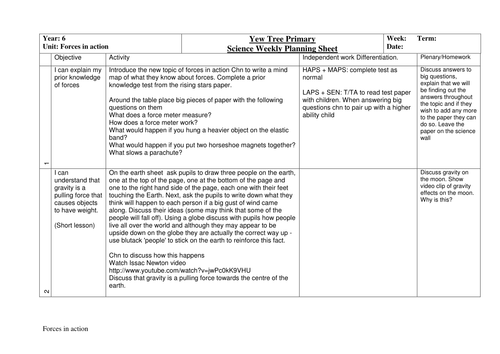







Something went wrong, please try again later.
Hi Laura.<br /> <br /> Some problems with both your questions and answers. I'm guessing that you aren't Physics trained?<br /> <br /> Question 7 makes no sense.<br /> If you hold the object, rather than the forcemeter, then the forcemeter will show the weight of the forcemeter.<br /> Your answer of 'So it doesn't add any more Newtons to the object' is simply wrong!<br /> <br /> Question 14.<br /> Gravity is acting downwards so you need an equal force acting upwards otherwise the moving car would accelerate downwards. This upwards force is the reaction from the ground. Your answer should say gravity, reaction from ground propulsion, air resistance and friction. Or scrub this question entirely if Y6 aren't taught about reaction forces.<br /> <br /> Question 16.<br /> If gravity was stronger than air resistance, the parachute would accelerate downwards (Force = Mass x acceleration meaning an overall an force acting on an object (which is a mass) makes a mass accelerate).<br /> The parachute was already moving downwards so when the force of gravity is matched by the air resistance (the point of your question I think), there would be no overall downwards force acting on the parachute, so no overall acceleration (which means no change in its motion), so it continues to move downwards at the SAME speed. In the equation F = mass x acceleration both F and acceleration are both zero.<br /> <br /> Question 21 is a badly worded question.<br /> An aircraft in flight, for example, has lift which opposes gravity so 'air resistance' on its own is an insufficient answer. Air resistance only plays a part in opposing gravity if the object (aircraft in this example) is moving downwards. Rockets also have a force (from the rocket engines) that opposes gravity to accelerate the rocket off the launch pad. As the rocket is moving upwards, air resistance would be acting in the SAME DIRECTION as gravity (both trying to oppose the rocket's forward motion).<br /> <br /> Question 24.<br /> The force of gravity isn't any different if you add more mass. Adding more mass makes the object weigh more (go back to the equation Force = mass x acceleration again). The force F is bigger because M (the mass) is bigger whilst g (the acceleration due to gravity - the force of gravity if you like) remains constant (the value is 9.81 m/s2 - but we use 10 in calculations for simplicity). This is why a 100g 'weight' has a weight of 1N (actually it is a mass of 100g) - put these values into F = m x a and remember that mass is measured in kg not g and that a = acceleration due to g = 10). The equation then becomes W (the weight) = mass (in kg) x g (acceleration due to gravity = 10).<br /> <br /> Hence 10N (of weight) per kilogram (of mass) - at least here on the Earth it does.<br /> <br /> Question 26. Badly worded question.<br /> If the car is moving at 30mph this is a constant speed (otherwise you should say it is speeding up or slowing down). Thus the propulsive force = air resistance so the car doesn't change what it is doing in terms of speed (back to F = m x a again).<br /> If air resistance WAS bigger, the car would indeed slow down, but it wouldn't be doing 30mph (apart from instantaneoulsy at a single point in time).<br /> <br /> Picture Answers<br /> <br /> Skydiver.<br /> <br /> Parachute is open so we assume constant speed downwards (when a parachute opens there is a VERY RAPID deceleration to a new - and constant but lower - terminal velocity). The arrows should be the SAME size (not different) but opposite to gravity as you have.<br /> <br /> Skier.<br /> <br /> Which way the skier moving? If at approx 45 degrees as picture illustrates then air resistance would also be at 45 degrees (and pointing behind them). The friction (between skis and snow) would also be at 45 degrees and again pointing behind the skier. Propulsion (because of the change of GPE to<br /> KE has components both vertical (skier is losing height) and horizontal (skier is moving forwards due to slope of the hill). Very complex answer to your simple question, but overall the only arrow that is correct is that for the force of gravity!<br />
Thank you for sharing. Brilliant resources
Thanks for sharing all your hard work-great practical ideas
Thank you, the experiments are great and really engage the children.
it can help altot thanks<br /> and peace<br />
Report this resourceto let us know if it violates our terms and conditions.
Our customer service team will review your report and will be in touch.
